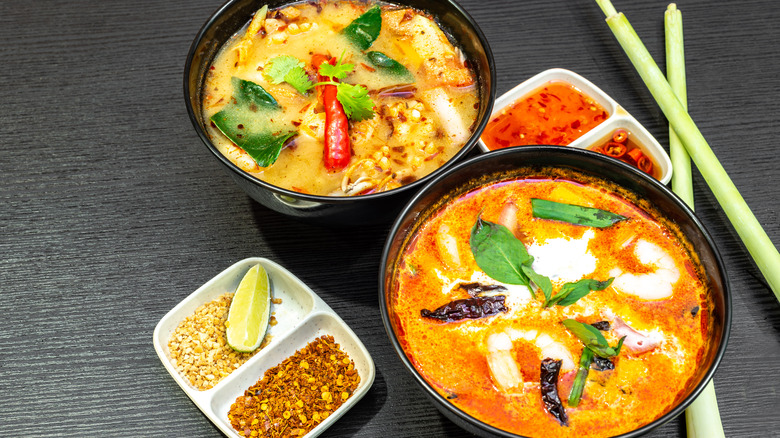Massaman Vs Panang Curry: What's The Difference?
The rich, flavorful, bright, layered flavors of Thai curry pastes are what make them so unique and, most likely, one of your favorite bases for your take-out meals on a Friday night.
The term 'curry' is used interchangeably to mean both 'curry paste' and 'curry' — the dish created using the curry paste. In the case of Massaman and Panang curry, we are talking about both. A quick intro to Thai curry pastes is needed to understand how they differ. Simply put, curry, or 'prik gaeng,' are aromatic spices ground with chilis. From there, each unique paste is built on a combination of spices, herbs, various chilis, and the all-important umami flavor, explains Serious Eats. Usually, shrimp paste is used to add salt and umami, but a vegetarian version can include fermented soybean paste.
North America is familiar with Thailand's curry rainbow – red, yellow, and green. Red curries rely on dried chilis, green from lighter, fresher green peppers, and yellow on turmeric root, explains Serious Eats. Pastes can be simple with only five ingredients to complicated and heavily layered with 15, like in Massaman.
Panang curry uses savory peanuts
Massaman and Panang curry may look similar as pastes, but their flavors differ, as do the ingredients that are usually put in their curry dishes. Panang is a red curry to start with, but it has a richness from the use of coconut milk and an unusual Thai ingredient — peanuts. The Spruce Eats explains it as being both rich and sweet. Because it's made with dried chilies, it has a slight heat.
Dating back to 1890, according to Asia Highlights, Panang is made with lemongrass, galangal, coriander, garlic, cumin, and shrimp paste. The coconut milk and peanuts make it thicker than most curries. What makes Panang's rich and developed flavor a little brighter is the addition of citrusy and fragrant kaffir lime leaf, as described by The Kitchn. Instead of being ground into the paste, lime leaves are tossed into the curry dish to wilt slightly. What you get is a flavor-loaded bite whose punch eventually mellows to the sweetness of the coconut milk, explains Great British Chefs.
Massaman curry uses many spices
According to Asia Highlights, Panang is excellent with beef, pork, or chicken but not fish since "it is a very thick stew without the soupy sauce to perfectly absorb the freshness of the seafood." Massaman, however, is better with beef and lamb and is never used with pork because of its Muslim roots, Noms Pedia explains. Massaman is unique in that it relies heavily on a large variety of spices which is unusual for Thai cooking and most likely a result of its development from Indian and Muslim influences (via Serious Eats).
It is a yellow curry and, therefore, mild since it doesn't get most of its flavors from chilies. Spices like cardamom, nutmeg, clove, and even cinnamon make this a warm, comforting, fragrant dish that is sweet and easy on the palate. Massaman and Panang are confused sometimes because both use peanuts, writes Let's Foodie. Peanuts and occasionally coconut milk make Massaman thick and rich, just like Panang, but with the added flavors of the spices, more fragrant and a little tangy, according to Chefd.


